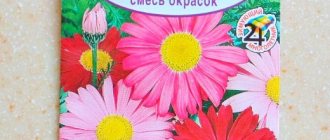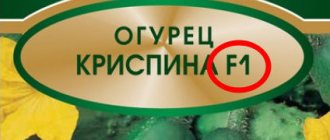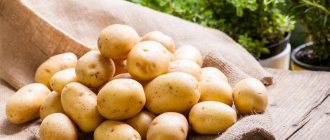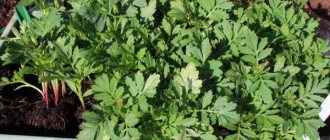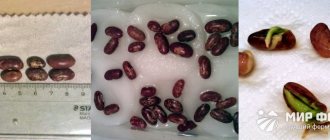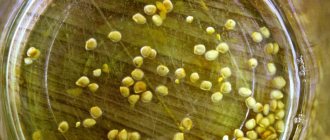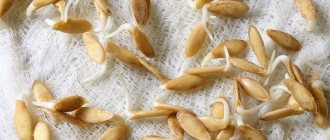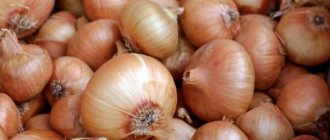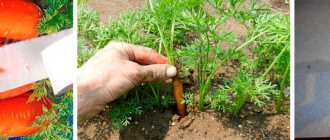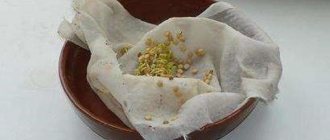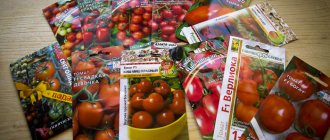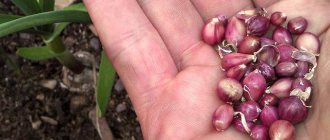Recommended timing of seed procurement for early-ripening, mid-ripening and late-ripening varieties. What tomatoes are suitable? Is it possible to use rotten fruits?
Collection rules and step-by-step instructions for the entire process. The most common mistakes and shelf life of seeds.
What to do if you decide to do this for the first time, where to start, how not to be left without a harvest in the coming year? How to get a fairly large number of seeds? You will find answers to all these questions in today's material.
Procurement time
To obtain a consistently high tomato yield, it is important to choose the right period for harvesting the fruit.
For early ripening varieties - this is the end of July, the beginning of August; for mid-season - the second ten days of August; for late ripening - you need to wait 1-2 weeks of September .
Be sure to take into account the growing region, and adhere to the principle: harvest at the peak of plant growth; it is not advisable to use the first and last fruits.
It is also worth taking the timing into account because this will allow the tomatoes to ripen completely, and you will be able to choose a good bush if you did not do this when planting.
Common mistakes
One of the main mistakes is choosing an atypical bush. If a variety suddenly germinates at a high rate, with a yield several times higher than declared, most likely this is a combination of circumstances and climatic factors; in the future, such a result is unlikely.
On a note! It is not recommended to choose tomatoes from bushes where all the fruits are of different sizes for the same reasons.
During the processing process, the workpieces do not use aluminum or iron utensils; it is better to choose clay, enamel or ordinary glass. Finished seeds are not stored for more than four years, even if they have been carefully processed.
Which tomatoes are suitable
The right choice of plant fruits will ensure success in growing tomatoes next year. Only specimens from strong, strong plants are suitable for selection. Tomatoes on such a bush should be similar in size, shape, and correspond to the characteristics of the variety.
Expert opinion
Zamyatina Alla Viktorovna
By profession - livestock breeder, work experience as a veterinarian - 10 years. Studying a second profession - agronomist
Collect fruits from the main trunk or from branches of the second or third order, fully ripened on the bush, without deformations. Due to weather conditions, premature harvesting of tomatoes of milky or blanzhe ripeness is allowed. The seeds ripen in such fruits, just as on the plant.
Some gardeners advise digging up a bush with unripe tomatoes from the ground and leaving it in a warm room to ripen. The quality is expected to improve significantly.
What are the best tomato seeds?
As a rule, experienced gardeners already have their favorite varieties that have been tested by time. But what about those who are just taking their first steps in growing tomatoes?
Experts recommend choosing those varieties that are most popular among summer residents. At the same time, you can grow several varieties at once, and at the end of the season decide which one is right for you.
Listed below are the tomato varieties that many gardeners and experts consider the best.
The best varieties for open ground
When choosing seeds for cultivation in open ground, you should consider where exactly you will grow them.
If this happens in mid-latitudes or in regions with colder climates, then preference should be given to the most frost-resistant, early-ripening varieties that are resistant to a variety of harmful insects and diseases.
Popular varieties:
- Raspberry Clink F1;
- Watercolor;
- Moravian miracle;
- Koenigsberg is golden;
- Visible-invisible;
- Supermodel;
- Alsou;
- Taimyr;
- Snowdrop;
- Yamal;
- Stolypin;
- Pudovik;
- F1 Big Beef;
- Three fat men;
- Altai yellow;
- Orange;
- Siberian trump card;
- Sweet heart F1;
- Appetizing;
- Dwarf;
- Aphrodite;
- Don Juan;
- Golden Stream and others.
The best varieties for greenhouses
Tomato variety Major F1
If you choose tomato seeds for growing in greenhouse conditions, then first of all you need to take into account the characteristics of the greenhouse itself.
You can grow both varietal and hybrid tomatoes there, which are adapted for growing at high levels of humidity, warmth, and poor ventilation. Another important factor is high resistance to diseases.
Most often, gardeners in their greenhouses grow vigorous, productive varieties, which bear fruit much longer than the low-growing ones. The fruits can be of different sizes, colors and shapes.
The best varieties:
- Honey Moon F1;
- Pink Claire F1;
- Supernova F1;
- Russian Happiness F1;
- Scarlet Mustang;
- Major F1;
- Openwork;
- Mercury;
- Doll Masha;
- Octopus F1;
- De Barao;
- Buffalo Heart;
- Southern tan;
- Honey drop;
- Madeira F1;
- Lollipop;
- Mikado pink and others.
The best varieties for the Moscow region and the middle zone
Tomato variety Sanka
When choosing tomato seeds for growing in mid-latitudes and in the Moscow region, in addition to personal preferences, you should take into account that the varieties must withstand sudden temperature changes during the day and night, as well as high air humidity, which can reach 75–80%.
It should also be taken into account that these regions have a relatively short growing season.
The most popular varieties:
- Sanka;
- Anyuta;
- Cheerful gnome;
- Shchelkovsky;
- Iceberg;
- Demidov;
- Fitous;
- Danko;
- Paradisaic delight;
- Bull's Heart;
- Winter cherry;
- Honey drop;
- Ildi and others.
The best varieties for the Urals
Tomato variety Alsou
In the Urals, tomatoes are most often grown in greenhouses. By maintaining optimal humidity and air temperature, gardeners are able to get a good harvest of tomatoes.
If you are choosing a variety to grow in the garden, then it is recommended to choose early-ripening or early-ripening varieties that are highly resistant to various diseases.
The best varieties:
- Lelya;
- Titanic F1;
- Kostroma F1;
- Wonderful lady;
- Samara F1;
- Alsou;
- Berdsky;
- Gina;
- King of Siberia;
- Alpha;
- Aurora F1;
- Scarlet candles;
- Golden Queen;
- Nezhdana and others.
The best varieties for Siberia
When choosing the best tomato seeds for Siberia, you need to take into account that the summer here is quite short, and the weather is changeable (either heat and drought, or prolonged rains and coolness). That is why it is recommended to grow varieties in such conditions that are resistant to sudden temperature changes and various diseases, and are characterized by high yields even in unfavorable conditions.
It is also better to choose early-ripening or early-ripening varieties that produce a harvest quickly and uniformly.
The best varieties include:
- Capsule;
- May early;
- Ultra-early;
- Generator;
- Countryman;
- Demidov;
- White filling;
- Visible-invisible;
- Oak;
- Honey saved;
- Gina;
- Rocket;
- Sweet bunch;
- Naughty;
- Sevruga and others.
The best varieties for the Leningrad region
Tomato variety Mishka in the north
When choosing tomato seeds for cultivation in the Leningrad region, attention should be paid to the fact that the climate here is characterized by high air and soil humidity, as well as a relatively small number of sunny days. Summer here is cool and short.
In this regard, gardeners try to grow tomatoes here that are highly resistant to diseases, the development of which is associated with high humidity, and they should also form a large number of ovaries at low air temperatures.
And in suitable varieties, the fruits should ripen quickly and have the ability to accumulate sugar with a small amount of light and heat.
The best varieties:
- Ground;
- Gribovsky 1180;
- White filling 241;
- North;
- Black Prince;
- Flash;
- Fighter;
- Bear in the north;
- Baltic;
- Northern beauty;
- Chanterelle and others.
The best productive and low-growing varieties
Tomato variety Aztec
Low-growing tomato varieties are good because instead of actively growing green mass, they form a large number of fruits.
In addition, compact bushes are often grown not only in the garden, but also in small greenhouses and greenhouses.
And low bushes are very easy to care for, since they do not require pinching, and they also do not need tying to a support.
The best varieties:
- Aztec;
- Balcony miracle;
- Betalux;
- Bonsai;
- Lady fingers;
- Orange Princess;
- Mascot;
- Duckling;
- Watercolor;
- Guarantee;
- Golden Stream;
- Aurora F1;
- Dubrava and others.
Is it worth harvesting seed material from hybrids?
Tomato seeds are divided into two categories: linear and hybrid.
Collecting hybrid seeds (label F1) is like playing roulette.
The probability of getting a high-quality next generation is very low , since there is a splitting of qualities in the second generation; it is unknown what will grow up.
For this reason, when collecting material, it is recommended to take only those fruits that are obtained from linear varietal seeds; they retain their qualities from generation to generation.
In this case, you can be sure that you will grow.
If you like the fruit, but you don’t know how and what it is grown from, you can collect the seeds and try to grow the plant. If the taste, shape, and size are preserved, it is a variety. In the future, you can safely collect seed material from it.
Other important characteristics of the variety are: plant growth, leaf type, fruit weight, color, size and number of chambers, external shape, quantity in the cluster.
What fruits can you collect seeds from?
Also check out these articles
- How many calories are in raspberries
- Planting spring garlic
- Garlic variety Gribovsky
- How to plant gooseberries with seedlings in spring
Many gardeners collect seeds from tomatoes, but only some produce a large harvest. Why is that? In order for the collected seeds to produce a large harvest in the future, you need to know which fruits are worth collecting them from. There are a few tricks here.
- Tomatoes can only be harvested from developed, strong plants. It is very important that they are free from diseases and that they are not affected by pests!
- Seed-bearing fruits are picked only from the lower, first branch of the bush.
- The tomato should be ripe, but not overripe. After all, when overripe, the protective shell of the seed is destroyed.
Tomato seeds photo
Interesting!
The largest tomato was grown by American Golden Graham in 1986. His weight was 3.5 kg!
- Usually the most beautiful, large (but not abnormally large) fruits are selected for planting material; one might say, a sample of the variety.
If you select candidates for seed collection in this way, they will bring a large, high-quality harvest in the future.
Collection rules
So, collecting seeds has the following rules:
- Collect fruits in dry weather.
- It is advisable that tomatoes of the same variety grow in the garden to avoid cross-pollination.
- Collect fruits only from varietal crops.
- Pay attention to the quality of the bush.
- If you collect seeds of several varieties, use different containers and do not forget to label them.
- Do not try to collect seeds from fruits of plants that are not adapted to your climate. Even if you received a good harvest this year, there is practically no guarantee of repeat success.
- Remove fruits for seeds separately from harvesting the main part of the harvest.
- Do not collect overripe tomatoes; the likelihood that the seeds will begin to germinate during the drying stage is too high.
Storage recommendations
In conclusion, let us allow ourselves a few more tips for “gardeners to take note”:
- It is better to store collected seeds in a cool, dark room (0-5°C). Ideally, on the refrigerator door.
- Planting material should not be stored in plastic bags or glass jars. Paper or fabric bags and matchboxes are best suited for this purpose.
- Tomato seeds retain good germination for 3-4 years. Every year the germination percentage will decrease.
- Don't forget to label all containers with seeds so as not to confuse the varieties.
We wish you success and great harvests!
Step-by-step instructions - how to properly grow tomatoes at home
After selection, we proceed to extracting the seeds and preparing them for long-term storage:
- Cut the tomato into slices to expose the seed chambers.
- Using a spoon, scoop out the seeds into a suitable container (plastic or glass, but not iron, as the oxidation process will begin). You can skip this step and just work with chopped fruits.
- Add a little water and leave for 2 days to start the fermentation and fermentation process. This is necessary to destroy the protective film that prevents the germination of seeds inside the fruit.
There is a high probability that mold will form on the surface, it’s not a big deal, just remove it. Sometimes, especially in cool weather, the fermentation period should be increased to 5 days, but monitor the process, as the seed coat may begin to dissolve.In general, the fermentation process imitates the natural life cycle of the plant and contributes to the disinfection of the material.
- After two days, drain the liquid, add running water, and shake well.
- We calibrate the seeds: those that float on the surface are of low quality, we get rid of them; those that have sunk to the bottom are left behind. A salt solution will also help select quality specimens. To do this, place them in a 3% salt solution and also select only those that remain at the bottom.
- We wash the remaining ones with running water and proceed to drying.
- They are dried in stages: first, they are laid out on a flat surface in a thin layer, then transferred to fabric bags, where the seeds will finally dry. Dry until completely free of moisture. Some people prefer to use special dryers.
Expert opinion
Ulanin Konstantin Grigorievich
Agronomist, work experience in the specialty - 12 years
There are several nuances in drying that it is advisable to take into account: the temperature should be 22-25 C°, humidity 40-60%, no direct sunlight. If you dry it in a cool room, you will get poor quality material.
Preparing for collection
Do-it-yourself tomato seeds are selected material, and therefore are a priori better than those sold in packs. The gardener himself chooses the largest and most viable material. He rises together. It also has a strengthened immune system.
Important! Tomato is a self-pollinating crop. The probability of preserving the properties of the mother plant is close to 100%.
Before harvesting tomato seeds, you should consider:
- The plant must be varietal. The hybrid cannot be propagated. Their creation is the delicate work of breeders. The offspring of hybrid tomatoes are unsightly. Such tomatoes are easily recognized by the F1 mark.
- The variety must be zoned for your region. A tomato adapted for the south can produce a good first generation harvest in cool regions. But it will not form high-quality seeds. Some of them will not sprout.
For the rest, the farmer can rely on his own taste. To obtain good seed, you need to choose the right time to collect it. Hurry up: the seeds will not ripen and will not produce healthy seedlings for next year. Miss the time - the fruits will become infected with late blight or have time to sprout directly in the tomato pulp.
The best time to collect seeds is determined by the ripening of the fruit. They should fall in the middle of fruiting of tomatoes:
- for early varieties - the period at the turn of July and August;
- for mid-season - end of August;
- for late ones - mid-September (if the climate of the region allows).
Two more ways to collect - “for the lazy”
Some gardeners use the fastest way to prepare seeds. Remove, immediately dry (5-7 days) without additional processing and store .
Judging by the reviews, the germination rate of such seeds is only slightly inferior to those prepared using the classical method.
Well, when you don’t want to deal with seeds at all, you can bury a whole tomato in the place where you want to get a bush next year . Dig not too deep, 2-3 cm. Sprinkle mulch on top to prevent winter cold from spoiling the seeds.
Necessary materials for collecting seeds
The following tools and materials will be needed for the seed procurement process:
- tomatoes with which work will be carried out;
- clean plates;
- small sieve;
- several napkins;
- container in which soaking will take place;
- paper or cloth bags for storing ready-made seeds (the ties must be loosened);
- pencil or pen for writing on bags.
After everything is prepared, you can begin processing the tomatoes and extracting the seed. Next we will tell you how to get seeds for seedlings from tomatoes.
Sectional view of a tomato
Useful tips
There are several recommendations that you can take note of and, if desired, adhere to them. When planting seedlings, determine the healthiest and strongest bushes from which you will collect fruits .
Take care of them more carefully; use cotton wool to protect the flowers from cross-pollination (by wrapping cotton wool around the base of the flower). Although tomatoes are self-pollinating plants, sometimes thrips insects can contribute to the formation of a hybrid fruit on your site.
Already obtained seeds can be disinfected using 72% laundry soap (in the proportion of 1 tablespoon of soap per glass of water). Soak in this solution for 30 minutes.
You can dry the seeds on toilet paper or paper napkins , then store and plant them together with the paper.
The easiest way
This is the method I used. I don’t need seeds in glasses; 10–20 of each variety I like is enough. That is, half or a quarter of a tomato is enough. Portions with seeds are very small in size - about a teaspoon. There is nothing to ferment; the juice will dry out rather than separate. Therefore, I laid out the seeds I needed directly on a piece of newspaper and dried them. Of course, the seeds turned out not as beautiful as in the store; a red film remained and dried on them, but this did not affect germination. I think, on the contrary, the dried juice served as additional nutrition and stimulant during germination in the spring. If you have the desire and time, you can first wash the seeds on a sieve and then dry them.
Common Mistakes
Let's look at the mistakes that are often encountered when preparing seeds:
- Collection from hybrid plants. Productivity and taste will change significantly.
- Choose the largest fruit that is not typical for this variety. The probability of getting the same large fruits is too low.
- Fans of self-selection can choose fruits of atypical shape, which will also reduce the quality of the seed material.
- Humidity problems during storage. This leads to the formation of mold on the seeds and it no longer makes sense to use them - all seeding qualities are lost.
How to select tomatoes correctly or 5 main mistakes
To obtain high-quality seed material on the site, we select 1-2 productive plants, which we carefully care for. It is not recommended to take fruits from the total mass for seed purposes. They may come from either diseased or low-yielding plants.
For seeds, take well-formed fruits typical for a given variety from the 2-3rd cluster (if grown in a greenhouse) and from the lower cluster (if grown in an open area). Tomatoes formed later are not suitable, since their offspring will have small fruits.
Before selecting tomatoes for seeds, you should familiarize yourself with the 5 most common mistakes.
- Inexperienced gardeners naively believe that hybrids can produce exactly the same tomatoes. This is impossible! Hybrid plants are obtained by crossing two or more varieties. The resulting seeds are first generation F1 hybrids. The main disadvantage of F1 hybrids is that you cannot take seeds from them, since the fruits may vaguely resemble the “parents” and be completely tasteless.
- Lovers take any fruit they like, forgetting that bees also participate in the pollination process. Consequently, it is also possible to obtain your own hybrids on the site. To avoid accidentally taking a hybrid plant, the fruits should be picked only from the lower cluster. The flowers bloom there in May, when bee activity is not yet high and the risk of cross-pollination is reduced to a minimum.
- Many people pick the largest tomato for seeds, without thinking about the fact that large size is not typical for this variety. The fruit grew so big only this year, thanks to a coincidence of circumstances.
- Those who like to experiment pick tomatoes that have an atypical shape for a given variety. If the typical shape of the variety is round, then you cannot take fruits that are cone-shaped or any other shape. Such fruits are victims of cross-pollination. For seeds, you need to take tomatoes that have pronounced typical characteristics for a given variety: size, fruit shape, color.
- Sometimes they rush to take overripe fruits. The seeds in such tomatoes may germinate and lose viability.
Shelf life without loss of germination
To ensure that the efforts spent on preparing seeds are not in vain, you need to properly store such material. It is better to use a paper or cardboard box or envelope.
Choose a place that is dry and dark, the ideal humidity for seeds is 55%, and the temperature is from 0 to 5 C° (suitable conditions in the refrigerator door). The viability of the material lasts for 9 years, but the longer you store it, the lower the quality, so a period of 4 years is considered optimal.
By learning the harvesting technique, you will not only ensure a stable harvest of your favorite tomato variety, but you will also be able to try to grow your own, choosing the best fruits from the most resistant bushes. Your plants will be more resistant to unfavorable environmental factors, and the germination rate of such seed material is much higher and more friendly.
The quantity of seeds prepared for planting will also please you and save your budget, because store packaging is often very small.
How to collect tomato seeds correctly
The fruits are picked in brown ripeness and ripen, spread out in a warm place. Before collecting tomato seeds, the fruits are washed, cut crosswise and, with light pressure, the pulp and juice are released into a glass or plastic container.
The seed coat contains substances that prevent their germination inside the fruit (inhibitors). The protective shell is destroyed during the fermentation process. A jar of tomato pulp is covered with gauze and placed in a dark place to ferment in its own juice for 2-3 days. Water cannot be added. In water, the seeds suffocate and die.
As soon as bubbles and a film appear on the surface of the contents of the jar, the juice becomes clarified, and the seeds sink to the bottom, the fermentation process is complete. It's time to separate the seeds. It is important not to miss this moment, otherwise they, freed from the protective shell, may begin to germinate right in the jar.
The risen fermented mass is carefully drained, clean water is added, the jar is shaken and the cloudy liquid is drained again. This is done several times.
Now you need to separate the empty, unripe seeds from the full-bodied ones. Take half a teaspoon of table salt per glass of water and stir. Place the seeds in the solution and shake: the full ones will sink to the bottom, the empty ones will float to the surface. Those that float up are thrown away without regret.
The remaining seeds are washed, squeezed onto a cotton cloth, poured onto paper, spread in a thin layer and dried for several days, stirring from time to time.
The prepared seed material is stored in paper bags in a dry place - tomato seeds are very afraid of moisture.
Germination persists for 5-9 years, but it is advisable to use them no later than 4 years.
How to properly plant tomatoes for seedlings in open soil?
To plant seedlings outdoors on time, count 65 days back from the moment when this can be done. For example, in your region it is allowed to plant tomatoes in early May, then start sowing seedlings in early March.
- For open ground, plant tomato seeds for seedlings no earlier than February 25th.
- If you plan to plant tomatoes in a greenhouse, then plant the seeds on February 20th.
in the soil
no later than April 1st. Because if you do this a little later, your tomatoes will begin to stretch out, as a result of which you will not get a harvest. This period especially applies to those people who live in the northern regions of the Russian Federation.
How to collect and prepare your own tomato seeds?
The difference between homemade tomato seeds and purchased ones is significant:
- Homemade material has an increased germination rate.
- The seeds are slightly larger in size.
- The resulting seedlings from home seeds are better able to tolerate diseases.
- Their yield is also better.
Getting ready
The process of collecting seeds goes like this:
- First, decide on the variety whose seeds you will collect.
- Choose strong, fruit-bearing tomato bushes.
- Collect seeds from completely ripe fruit. Pick a tomato and place it in a warm but dry place, for example, on a windowsill.
- When the tomato becomes soft, it means it is fully ripe.
- Cut the tomato, collect the pulp and seeds using a small spoon.
- Add water to the pulp so that the tomato seeds can separate from the pulp faster.
- Then rinse the seeds, dry them, and pack them into bags. To rinse the seeds, use a fine sieve or cheesecloth. Label the prepared bags, when exactly the material was collected, and the name of the variety.
In what cases can you collect seeds from tomatoes?
The most common cases in which it is possible to collect seeds yourself are:
- Propagation of existing seedlings by mother bushes.
- Creating the most acclimatized, healthy and fruit-bearing plantation is achieved by selecting healthy and fruit-bearing bushes.
- Constant problems with store-bought seeds, which do not allow the creation of normal bush seedlings.
- Lack of necessary varieties in the store assortment.
- Growing tomatoes and bush seedlings for sale.
- A rich harvest for the year, especially large fruits.
